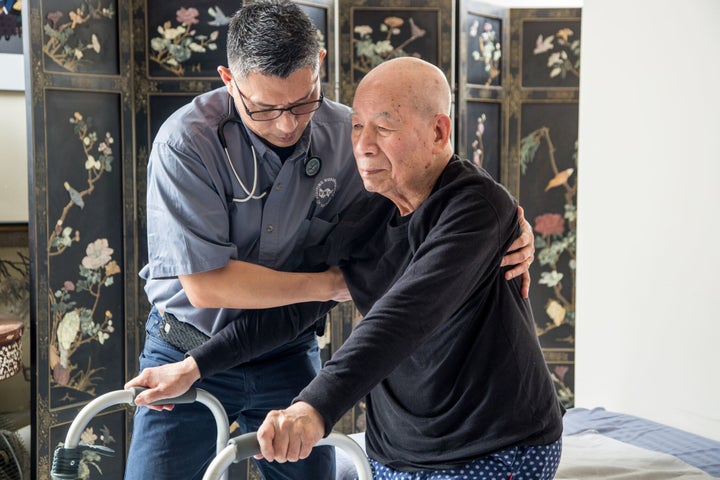
Mr. V*, in his mid-80s and suffering from leg pain due to diabetes, had fallen twice in as many weeks. To prevent a recurrence, occupational and physical therapists had helped his wife clear the apartment of tripping hazards and worked with him on safe ways to transfer in and out of chairs, walk with his walker and get up and down the two stairs to the living room.
Even after all these precautions, Mr. V still had several almost-falls at first. They happened when he was getting out of a chair and reached down to get his glasses from the side table. And again when he was brushing his teeth and took a step unassisted because the toothpaste was on the far counter. And then again when he turned quickly back towards the living room because he’d forgotten to take the crossword puzzle with him. For all the skills and knowledge he and his wife were learning about fall prevention, Mr. V had yet to practice one of the most important lessons of all: patience.
“I say to my patients, ‘Slow down, what’s the rush? You’re retired,’” says Allison Simms, a physical therapist with Visiting Nurse Service of New York. “But New Yorkers, they’re always in a hurry.”
Falls are the leading cause of injury for Americans age 65+. One in four older Americans falls every year, resulting in more than 2.8 million emergency room visits, 800,000 hospitalizations and 27,000 deaths, according to the U.S. Centers for Disease Control and Prevention. In addition to instability brought on by lack of conditioning and muscle strength that often occurs among older individuals, especially those who are less physically active, chronic conditions such as diabetes and hypertension can have side effects that take a toll on strength, balance and even eyesight, as can certain medications, amplifying the risk of falling. Falls often do more than physical damage, eroding confidence, leading to decreased activity, isolation and depression, and causing a downward spiral in physical and mental health.
For Falls Prevention Awareness Day, which aptly comes on September 22nd, the first day of Fall, I spoke with Allison and with Sonia Rapaport, a physical therapist who trains clinicians, home health aides and family caregivers in the art and science of fall prevention. Attention must be paid to the home environment, Allison and Sonia explain, as well as to the person—inside and out, taking into account what you cannot see as well as what you can. In addition to watching for tripping hazards, eye problems and loose clothing, caregivers must also be attuned to behavioral issues, such as resistance to giving up independence and the difficulty in relearning things that for decades have been habitual—reaching for a pair of glasses, or grabbing the forgotten crossword puzzle.
Here are Allison and Sonia’s recommendations on how to reduce the chances that you or a loved one will suffer an in-home fall.
Create a Safe Home Environment
- Keep paths clear and free of clutter.
- Eliminate throw rugs; they are a tripping hazard.
- Install proper lighting, bearing in mind that vision can decline as one ages and with certain illnesses.
- Keep equipment in good condition, such as walkers and canes.
Minimize Risk, from Head to Toe
- Maintain good eye health by getting regular eye exams and keeping eyeglass prescriptions current (and lenses clean). Glaucoma and cataracts, as well as diabetes symptoms, can interfere with vision.
- For caregivers supporting patients with weakness due to illness, injury or stroke, provide support on the weak side, at the person’s center of gravity.
- Because of reduced appetite, older people can lose weight over time. Make sure to keep loose clothing out of the way of walking, sitting or standing.
- Always wear shoes with closed toe and back—no socks or bare feet—when walking, even indoors and even when cultural traditions may favor stocking feet.
- Remain as active and strong as possible, following an appropriate exercise regimen.
- Overall, practice “nose over toes;” avoid leaning back or tilting to one side. Sonia suggests patients and caregivers repeat this as a mantra.
- Be mindful of medications; stay aware of side effects that could increase imbalance and paying special attention with any change in medication.
Help the Mind Stabilize the Body
Even when we create the right physical and environmental conditions to reduce falls for those who are frail and elderly, there are behavioral factors to consider—including helping people relearn, in a sense, something they’ve known how to do all their lives. “You want to do what you’ve always done—get up and go,” says Sonia, who trains caregivers with VNSNY and its private pay affiliate, Partners in Care. “It’s a big challenge, getting people to slow down and pay attention to everything they need to pay attention to.”
To avoid potentially dangerous stumbles, Allison encourages patients to break down the steps of every task. “I remind them to slow down their pace, and be thoughtful when completing a task—even an everyday routine like reaching for your glasses,” she says. She also advises investing in assistive equipment. Having reacher/grabber tools in several rooms, for example, makes it easier for someone who is unstable to reach for items on the floor or a far shelf without stretching and possibly losing their balance.
Finally, she counsels patients to work with their caregivers, and be ready to accept the added stability a watchful eye or supportive arm can provide. For Mr. V, independence came in the form of a small bell on his walker, which he agreed to ring whenever he wanted to get up from his chair to go into another room, have a meal, or use the bathroom. That allowed him privacy to work alone in his study, while giving caregivers peace of mind that he wouldn’t get up unattended.
“If someone is stubborn about their independence, I’ll make an agreement,” says Sonia. “I ask them to give up a little autonomy, so they can move around more—and more safely. Most people find that the ability to go where they want to is worth the compromise, even if it takes a little more time to get there.”
* Name changed to protect privacy
